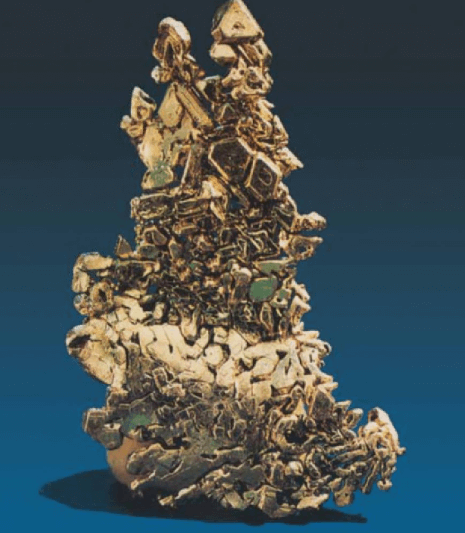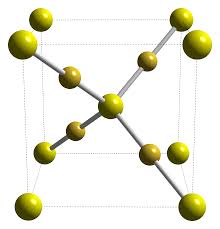Sulphites of Gold, alkaline sulphites, or sulphur dioxide, which reduce gold trichloride easily, do not produce the same effect on a solution of an alkaline aurate. If sodium bisulphite is added to a boiling solution of sodium aurate (NaAuO2) a yellowish precipitate is formed, soluble in excess of sodium bisulphite, and consisting of a double sulphite of gold and sodium, or sodium auro-sulphite, having the composition 3Na2SO3 . Au2SO3 + 3H2O. It is obtained pure by precipitating the corresponding barium salt with BaCl2, and decomposing the precipitate with the minimum quantity of sodium carbonate. Double sulphites of potassium and ammonium with gold also exist. These salts are decomposed by acids, sulphite of gold being deposited, and also on boiling their aqueous solutions, but the addition of sulphuretted hydrogen or alkaline sulphides has no effect on them.
Hyposulphites of Gold
These compounds are now called thiosulphates by chemists, but the old name is retained as being universally employed by metallurgists. They are especially interesting to the metallurgist, as on their formation depends the extraction of gold from auriferous silver ores, when these are treated by the ordinary hyposulphite, or by the Russell process. The soluble double hyposulphites of gold with the alkalies and alkaline earths have the general formula 3R”S2O3 . Au2S2O3 + 4H2O. The double compounds of gold with sodium, potassium, calcium, magnesium and barium are all known. The sodium salt is prepared by adding a dilute solution of gold trichloride little by little to a concentrated solution of sodium hyposulphite, when the following reaction occurs:
8Na2S2O3 + 2AuCl3 = Au2S2O3 . 3Na2S2O3 + 2Na2S4O6 + 6NaCl
The double hyposulphite may be separated by precipitation with strong alcohol, with which it is also washed, or it may be purified by repeated solution in water and precipitation with alcohol. Thus prepared, it consists of colourless crystalline needles, highly soluble in water, but almost insoluble in alcohol. The solution, which possesses a sweetish taste, decomposes under the influence of heat, the action being much more rapid when nitric acid is present ; metallic gold and sulphate of soda are formed. Gold, however, is not reduced from its solution as double hyposulphite by either stannous chloride, ferrous sulphate or oxalic acid, although sulphuretted hydrogen and alkaline sulphides give a black precipitate of Au2S3. The addition, of hydrochloric acid or of dilute sulphuric acid does not immediately cause an evolution of sulphur dioxide and a deposit of sulphur, as in the case of ordinary hyposulphites. Since, therefore, the double sulphite of soda and gold does not present the characteristics of either aurous salts or of hyposulphurous acid, it has been suggested that it contains a compound radical and has a composition expressed by either Na3S4O6Au or Na3S4O6Au + 2H2O. The addition of any dilute acid soon effects the decomposition of this body in solution, gold sulphide being precipitated; the reaction is accelerated by heat.
The double hyposulphites of potassium, calcium, barium and magnesium present similar characteristics. If the barium salt is treated with the amount of sulphuric acid required by theory, a solution of the acid auro-hyposulphite, 3H2S2O3. Au2S2O3, is obtained, but it cannot be crystallised. It has been supposed that the calcium salt is more easily formed than the sodium salt, and, therefore, that calcium hyposulphite is more suitable than sodium hyposulphite for use in the leaching process, whenever gold is present in perceptible quantities. According to a series of experiments conducted by Russell, this is not the case.
Russell has demonstrated that finely-divided gold is soluble to a limited extent (i.e., 0.002 gramme in 1,000 c.c. in 48 hours), in solutions of sodium hyposulphite of all degrees of concentration. The action depends on the oxidation of the gold by the air present in the solution, the soluble double hyposulphite, Au2S2O3 . 3Na2S2O3 + 4H2O, and caustic soda being formed.
The formation of this hyposulphite by the action of the sodium salt on gold sulphide is far more complete and rapid. In twenty- four hours at 15°, 0.066 gramme of gold, and in two hours at 65°, 0.117 gramme of gold were dissolved in dilute solutions. Since an alkaline sulphide will again precipitate Au2S3 from the solution, these facts seem to be at variance, and Stetefeldt suggests that the gold sulphide originally contained a small quantity of metallic gold in an excessively fine state of division, and that on heating more gold was set free. He instances Levol’s statement that sulphuretted hydrogen precipitates metallic gold, and not gold sulphide, from a boiling solution of the trichloride. He believes that it is only the free gold which is attacked, and that the results obtained on attacking the sulphide were better than those in which metallic gold was used, owing to the much finer state of division in which the gold existed in the former case. Another reason for the inverse reactions may of course exist in the influence of mass, the small quantity of sodium sulphide which is formed by the reaction being insufficient to precipitate any gold, which comes down on further additions of the same reagent.
